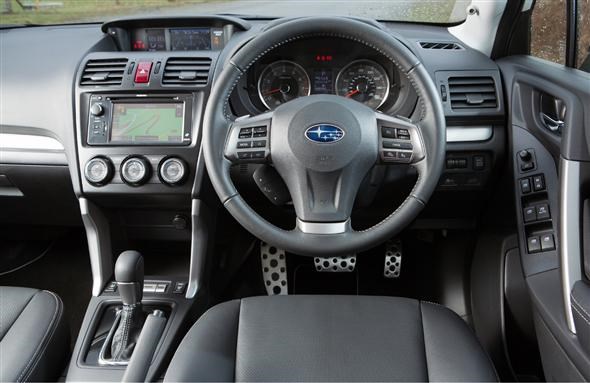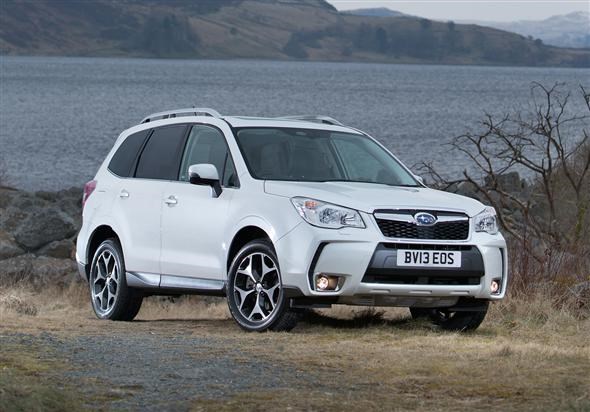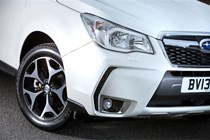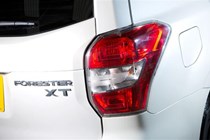To read up on the updated 2016MY Subaru Forester, our full road test can be found here
The original Subaru Forester Turbo was something of a game-changer when it first arrived, back in the late ’90s. Here was an estate car with enough ground clearance to manage some reasonably serious off-roading but also with enough performance to give the hottest of hot hatches a fright.
Now into its fourth generation, the Subaru Forester has morphed into more of a generic ‘soft roader’ but it’s still a tough, durable car that’s reasonably adept at tackling muddy terrain and there’s still a range-topping turbocharged petrol version.
Called the Forester XT, it has a 2.0-litre boxer engine developing 237bhp and a not-inconsiderable 350Nm of torque, which helps it to gather speed very quickly despite weighing more than 1,600kg. The 0-62mph sprint is dispatched in 7.5 seconds and top speed is 137mph.
Apart from the addition of a turbocharger, the engine’s actually the same as that used in the Subaru BRZ sports car.
In the Forester, it’s available only with Subaru’s ‘Lineartronic’ Continously Variable Transmission (CVT) automatic gearbox. Like other CVT-equipped cars, it can feel a little strange initially as there’s not the usual sensation of stepped gearchanges you’d feel and hear with a conventional automatic.

XT versions get leather seats, sat nav and powered tailgate as standard
Instead, the revs often remain high for long periods of time without dying away, which not only feels odd but can make for quite a noisy experience.
Nevertheless, you soon get used to it and a pair of manual gearchange paddles behind the wheel can be used to swap between preselected ratios. These make it feel more like a conventional gearbox and can be useful for overtaking.
Not that overtaking is much of a drama anyway, because the Forester XT is a genuinely quick car. Thanks to all that torque it builds speed rapidly and, happily, has a decent set of brakes to lose it again just as quickly.
For a 4x4 it’s pretty good at going around corners too. The boxer engine’s low centre of gravity and an improved suspension setup over the previous-generation Forester means there’s very little body roll and it feels really quite car-like to drive.
It’s just a shame that the steering is so unnecessarily light, as it lends the car a slightly disconnected feel.
Subaru anticipates that many Foresters will be subjected to some light off-road use, and the Lineartronic gearbox includes an ‘X-Mode’ setting which adjusts the sensitivity of the traction control system and throttle response to make it easier to find grip on muddy trails, as well as activating a hill descent control for tackling steep slopes.
If you’re likely to tackle any serious terrain, be warned that the turbocharger is mounted very low and could be susceptible to damage.
XT versions are the highest-specification Forester you can buy, and as such come with more equipment than the rest of the range including leather seats, sat-nav and a powered tailgate.
It looks different on the outside too, with larger wheels and false vents on the front bumper to make it appear a bit more aggressive.

Estate mixes practicality with some serious performance
It no longer has the distinctive letterbox style air scoop on the bonnet that typified previous Forester turbo models – that’s now hidden away under the bonnet behind a grille.
There are a few flaws: the humdrum interior appears dated compared with rivals and running costs aren’t particularly fantastic. It emits nearly 200g/km of CO2 while claimed average fuel consumption is 33mpg.
Nonetheless, the Forester may still find favour among buyers who need a car that can cope well with adverse terrain while still being able to cover ground pretty quickly on tarmac.
Parkers rating: 3 stars
Also consider:
Better off-road than the Forester thanks to a higher ground clearance, and not bad to drive on-road either. The 229bhp 3.2-litre auto version offers the best performance figures, with 0-60mph in 8.4 secs.
Not terribly exciting, but a very good car. Quickest is the 207bhp 2.0-litre TSI with a DSG auto ’box, which will get from 0-60mph in 7.1 secs.
Like the Forester it suffers from some rather anonymous styling both inside and out, but it’s very comfortable to drive on the road and is more spacious than the Subaru.
To read up on the updated 2016MY Subaru Forester, our full road test can be found here
Just so you know, we may receive a commission or other compensation from the links on this website - read why you should trust us.










